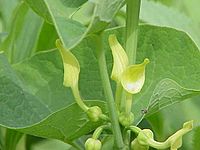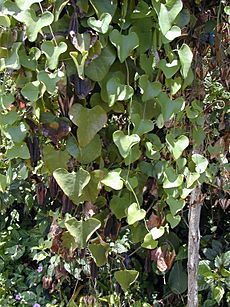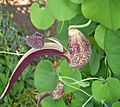Aristolochia facts for kids
Quick facts for kids Aristolochia |
|
|---|---|
 |
|
| Aristolochia clematitis | |
| Scientific classification | |
| Kingdom: | |
| Division: | |
| (unranked): | |
| Order: | |
| Family: | |
| Subfamily: | |
| Genus: |
Aristolochia
|
| Species | |
|
Over 500, see text |
|
Aristolochia is a large group of plants with over 500 different species. These plants can be shrubs or smaller herbs. They are often called birthworts, pipevines, or Dutchman's pipes because of their unique flower shapes.
These plants are found all over the world, growing in many different climates. Some species, like A. utriformis and A. westlandii, are in danger of disappearing.
A group of plants called Isotrema is usually included with Aristolochia. However, some scientists think Isotrema might be its own separate group. If it is, it would include species that have a calyx (the outer part of a flower) with three lobes.
About These Plants
Aristolochia plants can be lianas, which are woody vines that climb, or perennial herbs, which means they live for more than two years. Their stems are usually smooth and can grow straight up or twist around things.
The leaves are simple and grow one after another along the stem. They are often shaped like a heart and are thin. They grow on small stalks. These plants do not have stipules, which are small leaf-like parts at the base of the leaf stalk.
The flowers grow where the leaves meet the stem. They have a special shape: they are puffy and round at the bottom, then narrow into a long tube. This tube ends in a colorful, tongue-shaped part. Unlike many flowers, they don't have petals. The calyx (the outer part of the flower) can have one to three layers and three to six teeth. The sepals are joined together.
Inside the flower, there are usually six to 40 stamens (the parts that make pollen). These are joined with the style (part of the female reproductive organ) to form a special structure. The ovary (where seeds develop) is located below the other flower parts and has four to six sections.
These flowers have a very clever way of getting pollinated. They release a strong smell that attracts insects, especially flies. The inside of the flower's tube is covered with tiny hairs. These hairs act like a trap, letting the fly in but not letting it out easily. Once the fly is covered in pollen, the hairs wilt, allowing the fly to escape and carry the pollen to another flower.
After pollination, the fruit develops. It's a type of capsule that splits open when it's ripe, releasing many seeds. These seeds contain a special food source called endosperm.
Images for kids
-
Aristolochic acid, a main toxin found in pipevines
See also
 In Spanish: Aristolochia para niños
In Spanish: Aristolochia para niños














